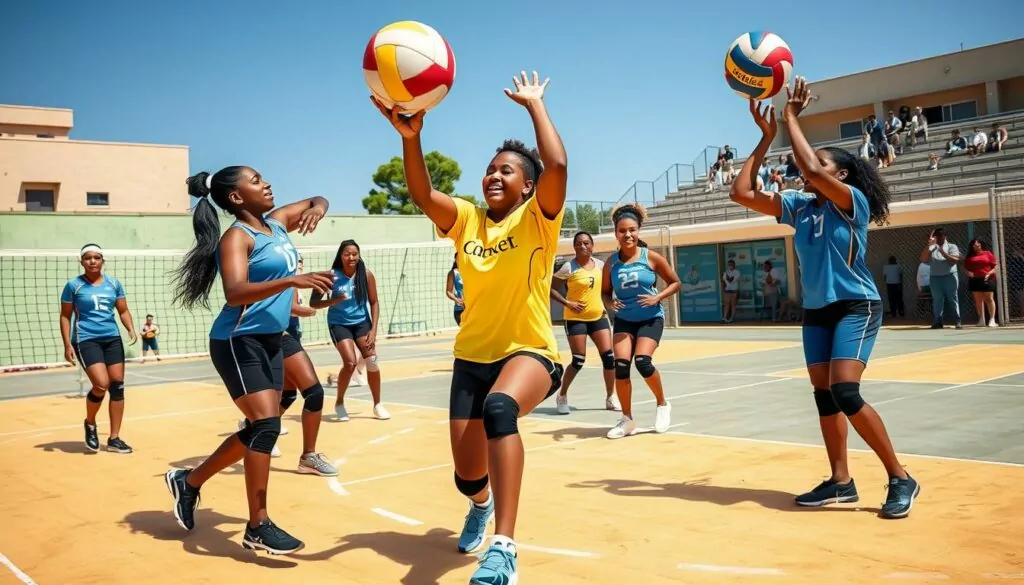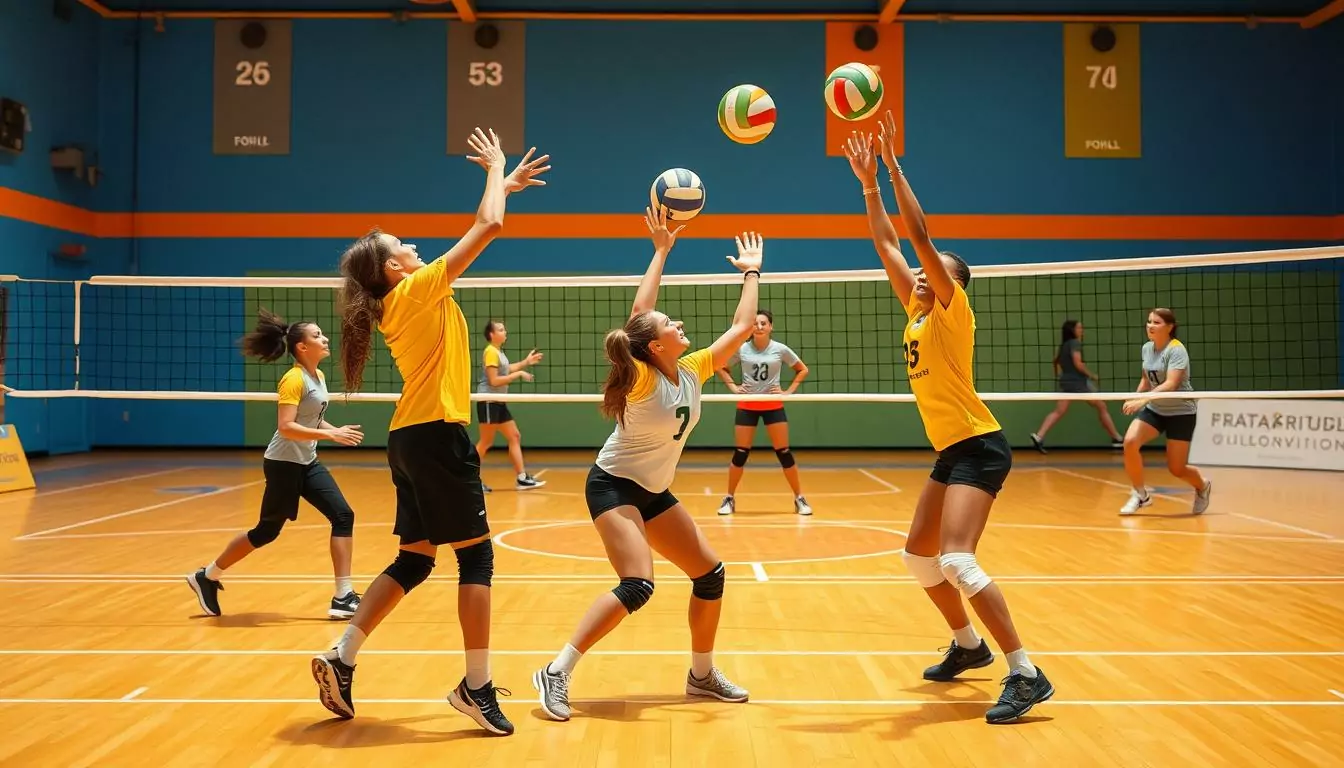I’ll never forget the day I stepped onto the volleyball court for my first game. As the ball sailed towards me, I froze, my hands flailing uselessly as it bounced off my chest. That moment sparked my journey to improve my volleyball hand-eye coordination. It’s a tale many players can relate to, and it highlights just how crucial this skill is in our sport.
Mastering ball handling skills isn’t just about practice; it’s about smart, targeted training. As I’ve learned, improving volleyball hand-eye coordination is key to elevating your game. Whether you’re a beginner or looking to refine your technique, the right approach can make all the difference.
In this guide, I’ll share the tips and tricks I’ve picked up along the way. From basic drills to advanced techniques, we’ll explore how to sharpen your reflexes and boost your performance on the court. Get ready to take your volleyball skills to the next level!
Key Takeaways
- Hand-eye coordination is essential for successful volleyball play
- Regular practice of targeted drills enhances ball handling skills
- Visual training exercises can significantly improve coordination
- Advanced techniques help develop quicker reaction times
- Technology can be a valuable tool in coordination training
- Consistent practice leads to noticeable improvements in game performance
Understanding Hand-Eye Coordination in Volleyball

As a volleyball player, I’ve learned that eye-hand synchronization is key to success on the court. Let’s dive into the science behind this crucial skill and explore why it’s so important for players at all levels.
The Science Behind Visual Processing and Motor Skills
Eye-hand coordination involves a complex interplay between our visual system and motor skills. When we see the ball, our brain processes this information and sends signals to our muscles to react. This happens in milliseconds, making volleyball a true test of our nervous system’s efficiency.
Why Hand-Eye Coordination is Crucial for Volleyball Players
In volleyball, split-second decisions can make or break a play. Good hand-eye coordination allows us to:
- Accurately serve the ball
- Make precise passes to teammates
- React quickly to incoming spikes
- Position ourselves correctly on the court
Without these skills, even the most athletic player would struggle to perform effectively.
Common Coordination Challenges in Volleyball
Many players face coordination hurdles. Some common issues include:
| Challenge | Impact | Solution |
|---|---|---|
| Misjudging ball trajectory | Missed passes or hits | Practice tracking drills |
| Slow reaction times | Late blocks or digs | Quick response exercises |
| Poor peripheral vision | Limited court awareness | Court awareness drills |
By addressing these challenges through targeted practice, we can significantly improve our performance on the court.
Essential Ball Handling Drills for Better Control

I’ve found that mastering ball handling skills is crucial for any volleyball player. Let’s dive into some effective drills that can help you improve your control and coordination on the court.
Solo Wall Practice Exercises
Wall practice is a great way to hone your reflexive movements. I start by standing about 3 feet from a wall, tossing the ball against it, and catching it. As I get better, I increase the distance and add variations like alternating hands or using different ball touches.
Partner Toss and Catch Variations
Working with a partner takes ball handling to the next level. We face each other about 10 feet apart and toss the ball back and forth. We mix it up by adding spins, changing heights, or incorporating quick movements between catches.
Dynamic Movement Drills with the Ball
To really challenge my ball handling skills, I incorporate dynamic movements. This might include dribbling the ball while shuffling side-to-side or doing figure-eights around my legs while walking. These drills improve my coordination and prepare me for game-like scenarios.
| Drill Type | Focus Area | Difficulty Level |
|---|---|---|
| Wall Practice | Hand-eye coordination | Beginner |
| Partner Toss | Ball control | Intermediate |
| Dynamic Movement | Reflexive movements | Advanced |
By consistently practicing these drills, I’ve seen significant improvements in my ball handling skills. Remember, the key is to start simple and gradually increase the difficulty as you progress.
Improving Volleyball Hand-Eye Coordination Through Visual Training
![]()
Visual training is key to boosting hand-eye coordination in volleyball. I’ve found that incorporating visual tracking exercises into my practice routine has significantly improved my on-court performance. These drills sharpen my ability to follow the ball’s movement and react quickly.
One effective drill I use involves tracking a ball hung from a string. I move my head in different directions while keeping my eyes fixed on the ball. This helps train my eyes to stay locked on moving objects, much like tracking a volleyball during a game.
Peripheral vision training is another crucial aspect of visual training for volleyball players. I practice this by focusing on a central point and identifying objects in my side vision without moving my eyes. This skill is invaluable for maintaining court awareness during fast-paced rallies.
| Visual Training Exercise | Benefits | Frequency |
|---|---|---|
| Ball on String Tracking | Improves focus and eye movement control | 3 times per week |
| Peripheral Vision Drill | Enhances court awareness | 2 times per week |
| Near-Far Focus Shifts | Develops visual adaptability | Daily |
By integrating these visual training techniques into my volleyball practice, I’ve noticed a marked improvement in my ability to read serves, track spikes, and anticipate plays. The key is consistency and gradual progression in difficulty to keep challenging your visual system.
Advanced Reaction Time and Peripheral Vision Exercises
In volleyball, quick reflexes and wide visual awareness are game-changers. I’ve found that advanced exercises targeting these skills can significantly boost performance. Let’s dive into some powerful techniques to sharpen your on-court responsiveness.
Quick Response Drills
Reaction drills form the backbone of improving split-second decision-making. I love using randomized ball tosses where a partner throws volleyballs from different angles. This forces me to react swiftly, mimicking real game scenarios. Another favorite is the “color call” drill, where different colored balls correspond to specific actions.
Multi-Ball Training Techniques
Multi-ball training takes reaction time to the next level. I set up a drill where multiple balls are served rapidly, requiring quick transitions between plays. This simulates the fast-paced nature of volleyball rallies and enhances my ability to process multiple stimuli simultaneously.
Court Awareness Enhancement Methods
Developing court awareness is crucial for anticipation practice. I use a “blind volley” drill where I face away from the court and turn only when I hear the ball being hit. This sharpens my ability to quickly assess the court layout and player positions. Another effective method is playing small-sided games with restricted court vision, forcing reliance on peripheral awareness.
“The best players don’t just react; they anticipate. These drills help you see the game before it unfolds.”
By incorporating these advanced exercises into your training routine, you’ll notice a marked improvement in your reaction time and court awareness. Remember, consistency is key in developing these skills.
Integrating Technology and Equipment for Coordination Practice
Technology has revolutionized volleyball training, offering innovative ways to improve hand-eye coordination. I’ve found that incorporating these tools into practice sessions can lead to significant gains in performance.
Training Apps and Virtual Tools
Many apps now offer dynamic vision drills tailored for volleyball players. These digital platforms provide interactive exercises that challenge your eye-hand synchronization in a fun, engaging way. Virtual reality (VR) systems have also emerged, simulating game scenarios to sharpen your reflexes and decision-making skills.
Specialized Equipment for Vision Training
Strobe glasses are a game-changer for vision training. They briefly block your vision, forcing your brain to process visual information more efficiently. Light board systems with touch-sensitive panels are another excellent tool for improving reaction times and peripheral awareness.
Tracking Progress with Technology
Wearable devices now allow us to monitor our performance metrics in real-time. These gadgets track factors like reaction speed and movement patterns, providing valuable data to refine our training approach. Some systems even use AI to analyze your technique and offer personalized feedback for improving eye-hand synchronization.
By embracing these technological advancements, we can take our volleyball skills to new heights. The key is to integrate these tools thoughtfully into our practice routines, ensuring a balanced approach to skill development.
Conclusion
Improving volleyball hand-eye coordination is a journey that requires dedication and practice. Throughout this article, we’ve explored various techniques and drills designed to enhance this crucial skill. From basic ball handling exercises to advanced reaction time drills, each method plays a vital role in developing a player’s overall coordination.
I can’t stress enough how important it is to incorporate these strategies into your regular training routine. By consistently working on visual processing, motor skills, and court awareness, you’ll see significant improvements in your game. Remember, the key to success lies in repetition and gradual progression.
As you continue improving volleyball hand-eye coordination, don’t forget to make use of available technology and specialized equipment. These tools can provide valuable feedback and track your progress over time. With persistent effort and the right approach, you’ll soon find yourself making split-second decisions and executing precise movements on the court with ease.
